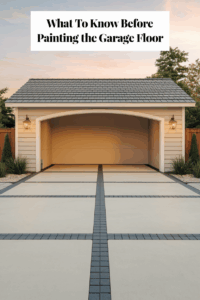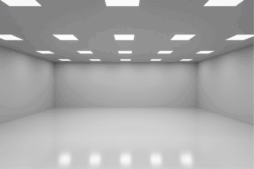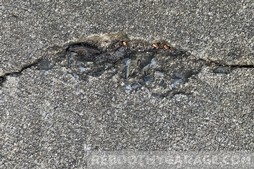Painting your garage floor is a great way to spruce up the space while also protecting the concrete.It is also the most likely floor covering to fail. To get a nice paint job that does not fail in three years, you need to etch, repair, vacuum, mop, and dry the floor first.Concrete loves water, and paint does not.Even epoxy-enhanced “concrete paint” will fail on an unprepared floor.Paint is the most affordable garage floor coating, at least up front.Paint does not last as long as epoxy or PVC tiles, but they cost more upfront.Paint does protect the concrete from spalling, pitting, and cracking.Anything that separates salt, sand, and ice from the concrete will protect the concrete.
Takeaway
Clean the floor, and clean it again.Now clean it a third time.Make sure it’s dry.Then apply the pain.
#1: How To Prepare The Garage Floor For Painting
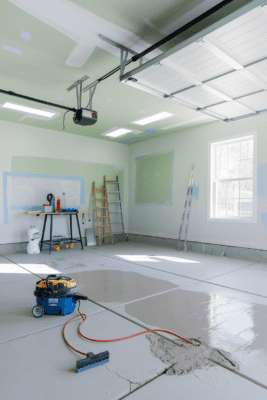
The objective of any coating preparation is to get the floor as flat and clean as possible.Step 1: Fix the floor first.If the concrete has holes, cracks, spalling, or pitting, you must fix these before cleaning.Go to the right column of this page for instructions on how to fix the floor.You might enjoy these articles we wrote explaining how to find and fix these problems: How Do You Fix Garage Floor Spalling and Pitting?, How Do You Fix Garage Floor Cracks? (they open in new windows)Step 2: Clean the floor with a vacuum. When you are done, use a push broom to kick up some dust.There will always be some dust embedded in the concrete, but this test will tell you how much.Vacuum the floor a second time if more than a little dust kicks up.We’re partial to wall vacuums like this one: What is the Absolute Best Garage Vacuum Cleaner in 2023 (opens in a new window).For those shopping for a garage vacuum, read our article: 11 Wall-Mounted Garage Vacuum Facts You Need to Know Before BuyingStep 3: Etch the floor with a non-acid etcher. The non-acid variety works as well as acid, without the noxious and burning behaviors.Etching is probably more important than cleaning for adhesion. You’ll need this article too: How Do You Fix Low Spots in Concrete? (opens in a new window)Step 4: Remove oil stains with a degreaser such as Purple Power.Paint will not stick to oil.Step 5: Wash concrete with a brush on a broom handle, and warm, soapy water.Use dish soap in a bucket of warm water to clean the floor.Here’s help cleaning; Don’t Clean Your Garage Floor Before Seeing ThisStep 6: Allow the floor to dry. Do not paint if you expect rain in the next 24 hours.
#2: What To Do If The Garage Floor Is Sealed
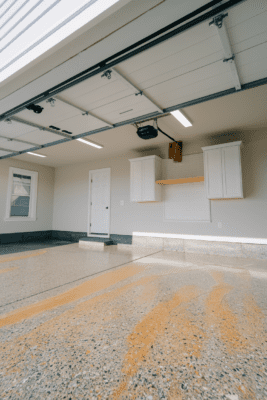
Bonus step: I once spent a summer failing at painting a wood fence because I had forgotten I coated the fence when I bought it. It had invisible oil protection covering the wood, so it failed at accepting paint.If your garage floor has a concrete sealer (also called water repellant),it might not accept acrylic paint or epoxy acrylic paint.Foundation Armor SX500, for example, is a concrete sealant that repels water to protect the floor from cracking, spalling, pitting, mold, etc.You may paint over a cured coat of this sealer with silicone emulsion or oil-based paint.Oil-based paint does not exist anymore.I researched “silicone emulsion” paint and did not find any for concrete garage floors. While the sealer instructs you to use silicone emulsion paint, you could probably use a concrete primer to seal in the sealer.Bottom line: call the company that manufactures red garage floor sealant before attempting to paint the garage floor.
#3: Do You Prime The Garage Floor Before Painting It?
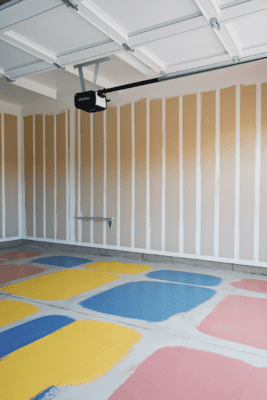
Priming is a good idea whether or not the paint is “self-priming.”A primer helps paint to stick.Since concrete is not that friendly to paint, anything you can do to increase adhesion will prolong the life of your work.Coating manufacturers chemically alter “self-priming” paint to stick better to surfaces.You do not need to use a primer with a primer-paint combo, but it will add overall adhesion. Concrete paint that does not contain a primer will need a primer coat before applying.
#4: Do You Need “concrete Paint” For The Garage Floor?

Concrete paint is a so-called 1-part epoxy acrylic paint. 1-part epoxy is not a thing; this is just a marketing term.Concrete paint has a better stickiness score, yet does not harden in the bucket.Concrete paint, then, is an epoxy acrylic, not a “1-part epoxy” acrylic.The concrete paint I buy also contains a primer, so it saves me the priming step as well.The advantage of concrete paint over standard acrylic is the bonding power. Concrete is porous, it loves to hold onto water.Paint loves dry areas.To get the paint to stick, epoxy acrylic is a better choice.
How Many Gallons of Paint Does a Garage Floor Need?
The formula for estimating paint is: (Area in square feet x number of coats) + 10%How many square feet is your garage floor? Multiply the length by the width, and then add 10% to that.Then get enough paint for that many square feet.In case you are comfortably reading this in your PJs, and prefer not to go outside to measure, here is a shortcut you can use for now.Do measure, though, before buying paint.Typical garage sizes:
- Small 1-car car garage: 10 x 16 ft (160 sf)
- Large 1-car car garage: 12 x 20 ft (240 sf)
- Small 2-car car garage: 20 x 20 ft (400 sf)
- Large 2-car car garage: 20 x 24 ft (480 sf)
- Average 3-car garage: 20 x 36 ft (720 sf)
- Average 4-car garage: 20 x 48 ft (960 sf)
Let’s say you have a large 2-car garage.That is 480 sf in area.You are going to put down a primer coat and two paint coats.Calculate how much paint you need as follows:How Many Gallons of Primer Cover a Concrete Floor?If you are using primer, get enough for the square feet plus 10%.For a 480 sf. large, 2-car garage:
- (480 sf x 1 coat) = 480 sf
- 480 × 10% = 4.5 (round up to 5)
- 480 + 5 = 485.
- Get enough primer to cover 485 sf.
How Many Gallons of Paint Cover a Concrete Floor?
The first coat might be enough. You can get enough paint for one coat and go back for a second, or just get enough for two coats up front.The two-coat quantity makes more sense.You can use it later to touch up dirty spots. A quart is 25% of a gallon, but a quart of paint usually costs about 50% of the gallon’s price.Just get the whole gallon.For a 2-car garage, that calculation looks like this:
- (480 sf x 2 coats) = 960 sf
- 960 × 10% = 9.6 (round up to 10).
- 960 + 10 = 970.Get enough paint to cover 970 sf.
#5: The Cost Of Painting The Concrete Garage Floor
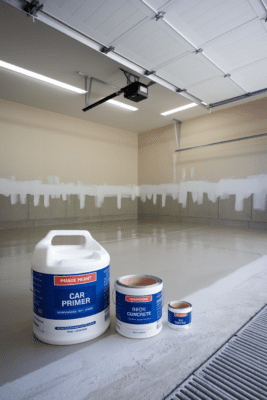
You will need one gallon of primer and two gallons of concrete paint to cover a large 2-car garage floor with primer and 2 coats of paint.A large 2-car garage is 480 sf.Each gallon of primer or paint covers about 500 sf.Therefore, you need one can per coat.A gallon of concrete primer costs about $24 and covers about 500 sf.A gallon of concrete primer epoxy paint costs about $38.Expect about 500 sf. of coverage per gallon.If you do one coat of primer, and one coat of paint, the total is $24 + $38 = $62.If you do one coat of primer and two coats of paint, the total is $24 + $38 + $38 = $100A 5-gallon bucket costs about $165.Inflation is strong as I write this, so your mileage may vary.While you save $25 off five gallons purchased individually, you will have a lot left over.If you need three gallons of paint to cover another concrete surface, then the five-gallon bucket price makes sense.If you leave an opened bucket around for a few years, it will spoil.
#6: Which Is Better For The Garage Floor: Acrylic, Acrylic Epoxy (“concrete Paint”), Or Epoxy?
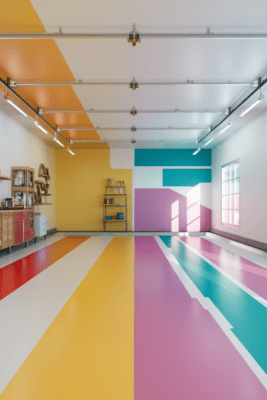
Concrete Paint Durability
Epoxy paint is the most durable.Concrete paint with epoxy is less durable than epoxy paint, and more durable than acrylic paint.
Concrete Paint Ease of Application
Acrylic and concrete paint are equally easy to apply. Epoxy paint is the hardest concrete coating to apply.The two parts will bond on contact.You must get them on the floor before they harden in the bucket.Epoxy is more durable than acrylic and so-called “concrete paint.”Epoxy, concrete and acrylic paints resist water, oil, gas, and chemicals.Acrylic and concrete paint do not resist scratching as well as epoxy does.
Concrete Paint Coatings Relative Costs
Epoxy concrete coating is the most expensive.Concrete epoxy paint is less expensive than epoxy coating, and more expensive than acrylic paint.
Concrete Paint Coating Preparation Differences
Epoxy, acrylic, and concrete paint require the same preparation.Vacuum, etch, repair, wash, and dry the floor before application.
#7: How Long Does Concrete Paint Last?

- Epoxy lasts 20 years.
- Epoxy acrylic concrete paint lasts five to 15 years.
- Acrylic paint lasts three to ten years.
All last longer when applied to a squeaky clean and dry floor.


